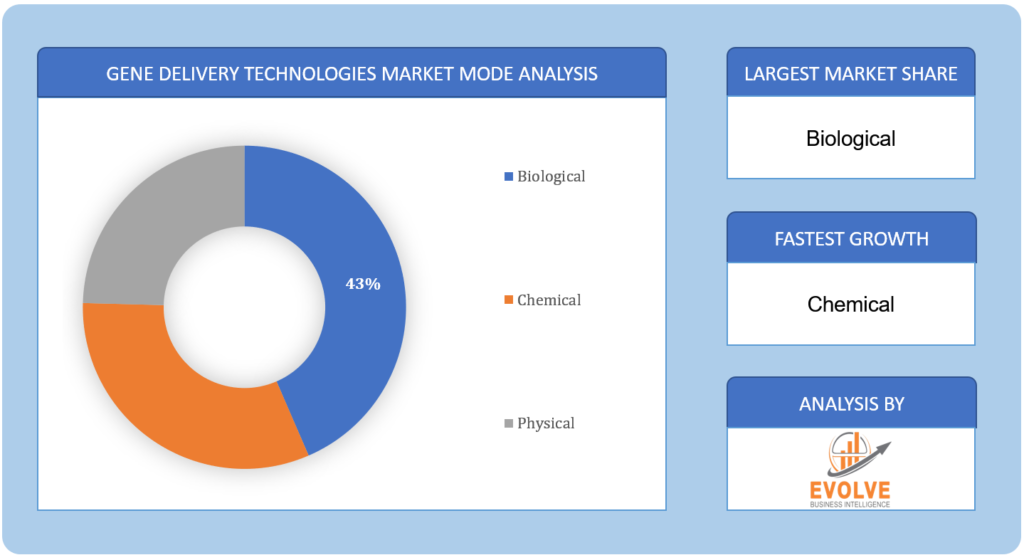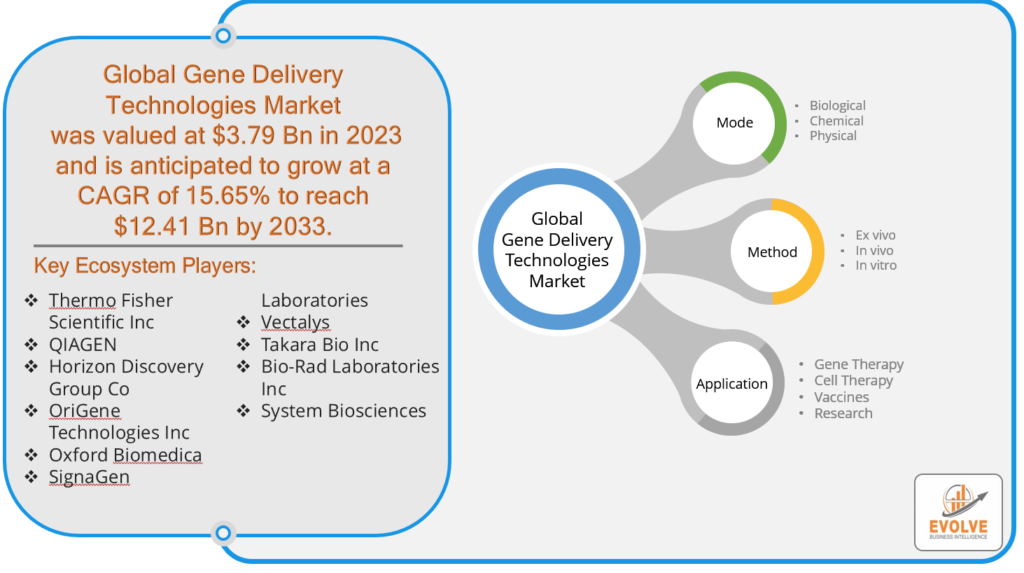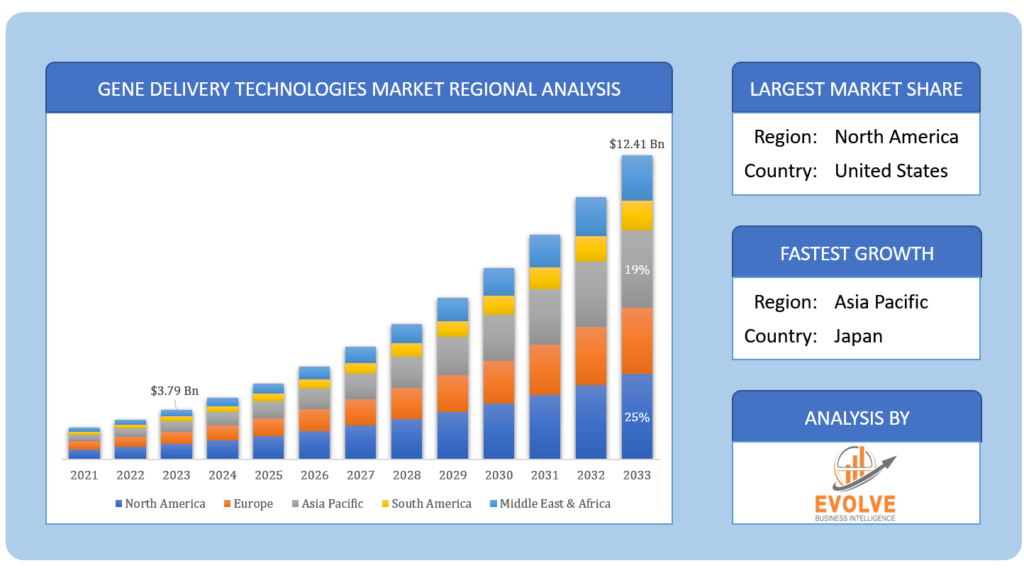Gene Delivery Technologies Market Analysis and Global Forecast 2023-2033
$ 1,390.00 – $ 5,520.00Price range: $ 1,390.00 through $ 5,520.00
Gene Delivery Technologies Market Research Report: By Mode (Biological, Chemical, Physical), By Method (Ex vivo, In vivo, In vitro), By Application (Gene Therapy, Cell Therapy, Vaccines, Research), and by Region — Forecast till 2033
Gene Delivery Technologies Market Overview
The Gene Delivery Technologies Market Size is expected to reach USD 12.41 Billion by 2033. The Gene Delivery Technologies industry size accounted for USD 3.79 Billion in 2023 and is expected to expand at a CAGR of 15.65% from 2023 to 2033. Gene Delivery Technologies refer to a diverse set of methods and techniques used to introduce specific genes, genetic material, or therapeutic nucleic acids into the cells of an organism. The primary goal of these technologies is to facilitate the transfer of genetic material into target cells, allowing for the modification, regulation, or augmentation of cellular functions. Gene delivery methods can involve the use of viral vectors, lipid-based nanoparticles, electroporation, physical techniques like microinjection, or other specialized approaches. These technologies play a crucial role in genetic research, gene therapy, and biotechnology applications by enabling the manipulation of genetic information to study gene function, treat genetic disorders, or develop novel therapeutic interventions.
Global Gene Delivery Technologies Market Synopsis
The Gene Delivery Technologies market experienced a dual effect from the COVID-19 pandemic. Initially, the pandemic disrupted supply chains, laboratory operations, and clinical trials, causing delays in research and development activities related to gene delivery methods and gene therapy treatments. However, as the pandemic underscored the importance of rapid vaccine development and genetic research, there was a subsequent surge in funding and collaborations within the biotechnology and pharmaceutical sectors, which boosted the demand for gene delivery technologies. This dichotomy of challenges and opportunities emphasized the critical role of gene delivery methods in responding to emerging infectious diseases and advancing genetic-based therapies, ultimately shaping the market’s dynamics during the pandemic and beyond.
Global Gene Delivery Technologies Market Dynamics
The major factors that have impacted the growth of Gene Delivery Technologies are as follows:
Drivers:
⮚ Growing Interest in Personalized Medicine
The Gene Delivery Technologies market is the increasing interest in personalized medicine. Tailoring medical treatments to an individual’s genetic makeup requires advanced gene delivery methods to introduce specific therapeutic genes or nucleic acids. As personalized medicine gains traction in oncology, rare diseases, and other fields, the demand for precise and efficient gene delivery technologies is on the rise.
Restraint:
- Safety and Regulatory
A significant restraint in the Gene Delivery Technologies market is the need to address safety concerns and navigate complex regulatory pathways. Ensuring the safety of gene therapies and gene-editing techniques is paramount, and adverse events can lead to setbacks and regulatory hurdles. Stringent regulatory oversight and evolving guidelines can slow down the development and approval of gene-delivery technologies and therapies, posing challenges to market growth.
Opportunity:
⮚ Emerging CRISPR-Cas9 Applications
An exciting opportunity lies in the expanding applications of CRISPR-Cas9 technology. CRISPR-based gene editing offers unprecedented precision in genetic modification, and its potential extends beyond therapeutics into areas like agriculture and biotechnology. As CRISPR-Cas9 technology matures and diversifies, the Gene Delivery Technologies market has the opportunity to cater to a wide range of applications, from curing genetic diseases to enhancing crop yields and developing novel bioproducts.
Gene Delivery Technologies Market Segment Overview
By Mode
 Based on the Mode, the market is segmented based on Biological, Chemical, and Physical. The Biological segment was projected to hold the largest market share in the Gene Delivery Technologies market due to its effectiveness in enabling gene therapy and vaccine development.
Based on the Mode, the market is segmented based on Biological, Chemical, and Physical. The Biological segment was projected to hold the largest market share in the Gene Delivery Technologies market due to its effectiveness in enabling gene therapy and vaccine development.
By Method
Based on the Method, the market has been divided into Ex vivo, In vivo, and In vitro. The Ex vivo segment is expected to hold the largest market share in the Gene Delivery Technologies market due to its critical role in gene editing and cell therapy applications.
By Application
Based on Application, the market has been divided into Gene Therapy, Cell Therapy, Vaccines, and Research. The Gene Therapy segment is expected to hold the largest market share in the Gene Delivery Technologies market due to its potential for treating a wide range of genetic diseases and disorders.
Global Gene Delivery Technologies Market Regional Analysis
Based on region, the market has been divided into North America, Europe, Asia-Pacific, the Middle East & Africa, and Latin America. The area of North America is anticipated to dominate the market for the usage of Gene Delivery Technologies, followed by those in Asia-Pacific and Europe.
 North America Market
North America Market
North America continues to assert dominance in the Gene Delivery Technologies market due to a combination of factors. The region’s robust biotechnology and pharmaceutical industries, well-established research infrastructure, and significant investment in gene therapy and genetic medicine contribute to its leading position. Furthermore, North America benefits from a favorable regulatory environment that fosters innovation and facilitates the development and commercialization of gene delivery technologies. The presence of key market players and collaborations with academic and research institutions further propel growth in this region. Additionally, a growing patient population with genetic disorders and a strong emphasis on personalized medicine drive the demand for gene delivery technologies, positioning North America as a major hub for gene therapy research, development, and commercialization.
Asia Pacific Market
The Asia-Pacific region has been experiencing remarkable growth in the Gene Delivery Technologies market in recent years, driven by several key factors. This dynamic growth is primarily attributed to the increasing healthcare expenditure, rising awareness of genetic diseases, and a burgeoning biotechnology sector in countries like China, India, Japan, and South Korea. The region’s large population base and a growing pool of talented scientists and researchers have fueled innovation and research in gene therapy and genetic medicine. Moreover, favorable government policies and regulatory reforms in some Asia-Pacific countries have encouraged investment in the biotechnology and pharmaceutical sectors, fostering a conducive environment for gene delivery technology development. The region’s potential for cost-effective manufacturing and a focus on healthcare modernization contribute to its rapid expansion and emerging significance in the global gene delivery technologies market.
Competitive Landscape
The competitive landscape includes key players (tier 1, tier 2, and local) having a presence across the globe. Companies such as Thermo Fisher Scientific Inc, QIAGEN, Horizon Discovery Group Co, OriGene Technologies Inc., and Oxford Biomedica are some of the leading players in the global Gene Delivery Technologies Industry. These players have adopted partnership, acquisition, expansion, and new product development, among others as their key strategies.
Key Market Players:
- Thermo Fisher Scientific Inc
- QIAGEN
- Horizon Discovery Group Co
- OriGene Technologies Inc
- Oxford Biomedica
- SignaGen Laboratories
- Vectalys
- Takara Bio Inc
- Bio-Rad Laboratories Inc
- System Biosciences
Key development:
In August of 2022, Vector BioPharma AG was introduced by Versant Ventures, establishing a biopharmaceutical firm dedicated to advancing a precise gene delivery platform that does not contain viral genes.
In November 2022, IMUNON initiated a technology assessment partnership with Acuitas Therapeutics to assess the compatibility of IMUNON’s PLACCINE plasmid DNA with Acuitas’ Lipid Nanoparticle Delivery System.
Scope of the Report
Global Gene Delivery Technologies Market, by Mode
- Biological
- Chemical
- Physical
Global Gene Delivery Technologies Market, by Method
- Ex vivo
- In vivo
- In vitro
Global Gene Delivery Technologies Market, by Application
- Gene Therapy
- Cell Therapy
- Vaccines
- Research
Global Gene Delivery Technologies Market, by Region
- North America
- US
- Canada
- Mexico
- Europe
- UK
- Germany
- France
- Italy
- Spain
- Benelux
- Nordic
- Rest of Europe
- Asia Pacific
- China
- Japan
- South Korea
- Indonesia
- Austalia
- Malaysia
- India
- Rest of Asia Pacific
- South America
- Brazil
- Argentina
- Rest of South America
- Middle East & Africa
- Saudi Arabia
- UAE
- Egypt
- South Africa
- Rest of Middle East & Africa
| Parameters | Indicators |
|---|---|
| Market Size | 2033: $12.41 Billion |
| CAGR | 15.65% CAGR (2023-2033) |
| Base year | 2022 |
| Forecast Period | 2023-2033 |
| Historical Data | 2021 |
| Report Coverage | Revenue Forecast, Competitive Landscape, Growth Factors, and Trends |
| Key Segmentations | Mode, Method, Application |
| Geographies Covered | North America, Europe, Asia-Pacific, Latin America, Middle East, Africa |
| Key Vendors | Thermo Fisher Scientific Inc., QIAGEN, Horizon Discovery Group Co, OriGene Technologies Inc, Oxford Biomedica, SignaGen Laboratories, Vectalys, Takara Bio Inc, Bio-Rad Laboratories Inc, System Biosciences |
| Key Market Opportunities | • The rapid development of CRISPR-Cas9 technology • The expansion of ex vivo gene therapies |
| Key Market Drivers | • Rising Incidence of Genetic Disorders • Advancements in Biotechnology • Growing Investment in Research and Development |
REPORT CONTENT BRIEF:
- High-level analysis of the current and future Gene Delivery Technologies Industry trends and opportunities
- Detailed analysis of current market drivers, restraining factors, and opportunities analysis in the future
- Historical market size for the year 2021, and forecast from 2023 to 2033
- Gene Delivery Technologies market share analysis for each segment
- Competitor analysis with a comprehensive insight into its product segment, financial strength, and strategies adopted.
- Identifies key strategies adopted by the key players including new product development, mergers and acquisitions, joint ventures, collaborations, and partnerships.
- To identify and understand the various factors involved in the global Gene Delivery Technologies market affected by the pandemic
- To provide year-on-year growth from 2022 to 2033
- To provide short-term, long-term, and overall CAGR comparison from 2022 to 2033.
- Provide Total Addressable Market (TAM) for the Global Gene Delivery Technologies Market.
Press Release

Global Pharmaceutical Manufacturing Market to Reach $1.38 Trillion by 2035 with 7.35% CAGR, New Research Shows

The Global Mammography Market Is Estimated To Record a CAGR of Around 10.29% During The Forecast Period

Glue Stick Market to Reach USD 2.35 Billion by 2034

Podiatry Service Market to Reach USD 11.88 Billion by 2034

Microfluidics Technology Market to Reach USD 32.58 Billion by 2034

Ferric Chloride Market to Reach USD 10.65 Billion by 2034

Family Practice EMR Software Market to Reach USD 21.52 Billion by 2034

Electric Hairbrush Market to Reach USD 15.95 Billion by 2034

Daily Bamboo Products Market to Reach USD 143.52 Billion by 2034

Cross-border E-commerce Logistics Market to Reach USD 112.65 Billion by 2034
Frequently Asked Questions (FAQ)
What is the study period of this market?
The study period of the global Gene Delivery Technologies market is 2022- 2033
What is the 10-year CAGR (2023 to 2033) of the global Gene Delivery Technologies market?
The global Gene Delivery Technologies market is growing at a CAGR of ~65% over the next 10 years
Which region has the highest growth rate in the market of Gene Delivery Technologies?
Asia Pacific is expected to register the highest CAGR during 2023-2033
Which region accounted for the largest share of the market of Gene Delivery Technologies?
North America holds the largest share in 2022
Major Key Players in the Market of Gene Delivery Technologies Manufacturers?
Thermo Fisher Scientific Inc, QIAGEN, Horizon Discovery Group Co, OriGene Technologies Inc, Oxford Biomedica, SignaGen Laboratories, Vectalys, Takara Bio Inc, Bio-Rad Laboratories Inc, System Biosciences.
Do you offer post-sales support?
Yes, we offer 16 hours of analyst support to solve the queries
Do you deliver sections of a report?
Yes, we do provide regional as well as country-level reports. Other than this we also provide a sectional report. Please get in contact with our sales representatives.
Table of Content
CHAPTER 1. Executive Summary CHAPTER 2. Scope of the Study 2.1. Market Definition 2.2. Market Scope & Segmentation 2.2.1. Objective of Report CHAPTER 3. Evolve BI Methodology 3.1. Data Collection & Validation Approach 3.2. Market Size Estimation and Forecast CHAPTER 4. Exclusive Analysis 4.1. Market Opportunity Score 4.1.1. Mode Segement – Market Opportunity Score 4.1.2. Method Segment – Market Opportunity Score 4.1.3. Application Segment – Market Opportunity Score 4.2. Key Market Influencing Indicators CHAPTER 5. Market Insights and Trends 5.1. Value Chain Analysis 5.1.1. Raw Material 5.1.2. Manufacturing Process 5.1.3. Distribution Channel 5.1.4. End User 5.2. Porter’s Five Forces Analysis 5.2.1. Bargaining Power of Buyers 5.2.2. Bargaining Power of Suppliers 5.2.3. Threat of New Entrant 5.2.4. Threat of Substitute 5.2.5. Industry Rivalry 5.3. COVID-19 Impact and Post COVID Scenario on Gene Delivery Technologies Market 5.3.1. Impact of COVID-19 5.3.2. Government Support and Industry Revival Policies 5.3.3. Measures Taken by Companies to Mitigate Negative Impact 5.3.4. Post COVID Trend CHAPTER 6. MArket Dynamics 6.1. Introduction 6.2. Drivers 6.2.1. Driver 1 6.2.2. Driver 2 6.2.3. Driver 3 6.3. Restraints 6.3.1. Restraint 1 6.3.2. Restraint 2 6.4. Opportunity 6.4.1. Opportunity 1 CHAPTER 7. Global Gene Delivery Technologies Market, By Mode 7.1. Introduction 7.1.1. Biological 7.1.2. Chemical 7.1.3. Physical CHAPTER 8. Global Gene Delivery Technologies Market, By Method 8.1. Introduction 8.1.1. Ex vivo 8.1.2. In vivo 8.1.3. In vitro CHAPTER 9. Global Gene Delivery Technologies Market, By Application 9.1. Introduction 9.1.1. Gene Therapy 9.1.2. Cell Therapy 9.1.3. Vaccines 9.1.4. Research CHAPTER 10. Global Gene Delivery Technologies Market, By Region 10.1. Introduction 10.2. NORTH AMERICA 10.2.1. North America: Market Size and Forecast, By Country, 2023 – 2033 ($ Million) 10.2.2. North America: Market Size and Forecast, By Mode, 2023 – 2033 ($ Million) 10.2.3. North America: Market Size and Forecast, By Method, 2023 – 2033 ($ Million) 10.2.4. North America: Market Size and Forecast, By Application, 2023 – 2033 ($ Million) 10.2.5. US 10.2.5.1. US: Market Size and Forecast, By Mode, 2023 – 2033 ($ Million) 10.2.5.2. US: Market Size and Forecast, By Method, 2023 – 2033 ($ Million) 10.2.5.3. US: Market Size and Forecast, By Application, 2023 – 2033 ($ Million) 10.2.6. CANADA 10.2.6.1. Canada: Market Size and Forecast, By Mode, 2023 – 2033 ($ Million) 10.2.6.2. Canada: Market Size and Forecast, By Method, 2023 – 2033 ($ Million) 10.2.6.3. Canada: Market Size and Forecast, By Application, 2023 – 2033 ($ Million) 10.2.7. MEXICO 10.2.7.1. Mexico: Market Size and Forecast, By Mode, 2023 – 2033 ($ Million) 10.2.7.2. Mexico: Market Size and Forecast, By Method, 2023 – 2033 ($ Million) 10.2.7.3. Mexico: Market Size and Forecast, By Application, 2023 – 2033 ($ Million) 10.3. Europe 10.3.1. Europe: Market Size and Forecast, By Country, 2023 – 2033 ($ Million) 10.3.2. Europe: Market Size and Forecast, By Mode, 2023 – 2033 ($ Million) 10.3.3. Europe: Market Size and Forecast, By Method, 2023 – 2033 ($ Million) 10.3.4. Europe: Market Size and Forecast, By Application, 2023 – 2033 ($ Million) 10.3.5. U.K. 10.3.5.1. U.K.: Market Size and Forecast, By Mode, 2023 – 2033 ($ Million) 10.3.5.2. U.K.: Market Size and Forecast, By Method, 2023 – 2033 ($ Million) 10.3.5.3. U.K.: Market Size and Forecast, By Application, 2023 – 2033 ($ Million) 10.3.6. GERMANY 10.3.6.1. Germany: Market Size and Forecast, By Mode, 2023 – 2033 ($ Million) 10.3.6.2. Germany: Market Size and Forecast, By Method, 2023 – 2033 ($ Million) 10.3.6.3. Germany: Market Size and Forecast, By Application, 2023 – 2033 ($ Million) 10.3.7. FRANCE 10.3.7.1. France: Market Size and Forecast, By Mode, 2023 – 2033 ($ Million) 10.3.7.2. France: Market Size and Forecast, By Method, 2023 – 2033 ($ Million) 10.3.7.3. France: Market Size and Forecast, By Application, 2023 – 2033 ($ Million) 10.3.8. ITALY 10.3.8.1. Italy: Market Size and Forecast, By Mode, 2023 – 2033 ($ Million) 10.3.8.2. Italy: Market Size and Forecast, By Method, 2023 – 2033 ($ Million) 10.3.8.3. Italy: Market Size and Forecast, By Application, 2023 – 2033 ($ Million) 10.3.9. SPAIN 10.3.9.1. Spain: Market Size and Forecast, By Mode, 2023 – 2033 ($ Million) 10.3.9.2. Spain: Market Size and Forecast, By Method, 2023 – 2033 ($ Million) 10.3.9.3. Spain: Market Size and Forecast, By Application, 2023 – 2033 ($ Million) 10.3.10. BENELUX 10.3.10.1. BeNeLux: Market Size and Forecast, By Mode, 2023 – 2033 ($ Million) 10.3.10.2. BeNeLux: Market Size and Forecast, By Method, 2023 – 2033 ($ Million) 10.3.10.3. BeNeLux: Market Size and Forecast, By Application, 2023 – 2033 ($ Million) 10.3.11. RUSSIA 10.3.11.1. Russia: Market Size and Forecast, By Mode, 2023 – 2033 ($ Million) 10.3.11.2. Russia: Market Size and Forecast, By Method, 2023 – 2033 ($ Million) 10.3.11.3. Russia: Market Size and Forecast, By Application, 2023 – 2033 ($ Million) 10.3.12. REST OF EUROPE 10.3.12.1. Rest of Europe: Market Size and Forecast, By Mode, 2023 – 2033 ($ Million) 10.3.12.2. Rest of Europe: Market Size and Forecast, By Method, 2023 – 2033 ($ Million) 10.3.12.3. Rest of Europe: Market Size and Forecast, By Application, 2023 – 2033 ($ Million) 10.4. Asia Pacific 10.4.1. Asia Pacific: Market Size and Forecast, By Country, 2023 – 2033 ($ Million) 10.4.2. Asia Pacific: Market Size and Forecast, By Mode, 2023 – 2033 ($ Million) 10.4.3. Asia Pacific: Market Size and Forecast, By Method, 2023 – 2033 ($ Million) 10.4.4. Asia Pacific: Market Size and Forecast, By Application, 2023 – 2033 ($ Million) 10.4.5. CHINA 10.4.5.1. China: Market Size and Forecast, By Mode, 2023 – 2033 ($ Million) 10.4.5.2. China: Market Size and Forecast, By Method, 2023 – 2033 ($ Million) 10.4.5.3. China: Market Size and Forecast, By Application, 2023 – 2033 ($ Million) 10.4.6. JAPAN 10.4.6.1. Japan: Market Size and Forecast, By Mode, 2023 – 2033 ($ Million) 10.4.6.2. Japan: Market Size and Forecast, By Method, 2023 – 2033 ($ Million) 10.4.6.3. Japan: Market Size and Forecast, By Application, 2023 – 2033 ($ Million) 10.4.7. INDIA 10.4.7.1. India: Market Size and Forecast, By Mode, 2023 – 2033 ($ Million) 10.4.7.2. India: Market Size and Forecast, By Method, 2023 – 2033 ($ Million) 10.4.7.3. India: Market Size and Forecast, By Application, 2023 – 2033 ($ Million) 10.4.8. SOUTH KOREA 10.4.8.1. South Korea: Market Size and Forecast, By Mode, 2023 – 2033 ($ Million) 10.4.8.2. South Korea: Market Size and Forecast, By Method, 2023 – 2033 ($ Million) 10.4.8.3. South Korea: Market Size and Forecast, By Application, 2023 – 2033 ($ Million) 10.4.9. THAILAND 10.4.9.1. Thailand: Market Size and Forecast, By Mode, 2023 – 2033 ($ Million) 10.4.9.2. Thailand: Market Size and Forecast, By Method, 2023 – 2033 ($ Million) 10.4.9.3. Thailand: Market Size and Forecast, By Application, 2023 – 2033 ($ Million) 10.4.10. INDONESIA 10.4.10.1. Indonesia: Market Size and Forecast, By Mode, 2023 – 2033 ($ Million) 10.4.10.2. Indonesia: Market Size and Forecast, By Method, 2023 – 2033 ($ Million) 10.4.10.3. Indonesia: Market Size and Forecast, By Application, 2023 – 2033 ($ Million) 10.4.11. MALAYSIA 10.4.11.1. Malaysia: Market Size and Forecast, By Mode, 2023 – 2033 ($ Million) 10.4.11.2. Malaysia: Market Size and Forecast, By Method, 2023 – 2033 ($ Million) 10.4.11.3. Malaysia: Market Size and Forecast, By Application, 2023 – 2033 ($ Million) 10.4.12. AUSTRALIA 10.4.12.1. Australia: Market Size and Forecast, By Mode, 2023 – 2033 ($ Million) 10.4.12.2. Australia: Market Size and Forecast, By Method, 2023 – 2033 ($ Million) 10.4.12.3. Australia: Market Size and Forecast, By Application, 2023 – 2033 ($ Million) 10.4.13. REST FO ASIA PACIFIC 10.4.13.1. Rest fo Asia Pacific: Market Size and Forecast, By Mode, 2023 – 2033 ($ Million) 10.4.13.2. Rest fo Asia Pacific: Market Size and Forecast, By Method, 2023 – 2033 ($ Million) 10.4.13.3. Rest fo Asia Pacific: Market Size and Forecast, By Application, 2023 – 2033 ($ Million) 10.5. South America 10.5.1. South America: Market Size and Forecast, By Country, 2023 – 2033 ($ Million) 10.5.2. South America: Market Size and Forecast, By Mode, 2023 – 2033 ($ Million) 10.5.3. South America: Market Size and Forecast, By Method, 2023 – 2033 ($ Million) 10.5.4. South America: Market Size and Forecast, By Application, 2023 – 2033 ($ Million) 10.5.5. BRAZIL 10.5.5.1. Brazil: Market Size and Forecast, By Mode, 2023 – 2033 ($ Million) 10.5.5.2. Brazil: Market Size and Forecast, By Method, 2023 – 2033 ($ Million) 10.5.5.3. Brazil: Market Size and Forecast, By Application, 2023 – 2033 ($ Million) 10.5.6. ARGENTINA 10.5.6.1. Argentina: Market Size and Forecast, By Mode, 2023 – 2033 ($ Million) 10.5.6.2. Argentina: Market Size and Forecast, By Method, 2023 – 2033 ($ Million) 10.5.6.3. Argentina: Market Size and Forecast, By Application, 2023 – 2033 ($ Million) 10.5.7. REST OF SOUTH AMERICA 10.5.7.1. Rest of South America: Market Size and Forecast, By Mode, 2023 – 2033 ($ Million) 10.5.7.2. Rest of South America: Market Size and Forecast, By Method, 2023 – 2033 ($ Million) 10.5.7.3. Rest of South America: Market Size and Forecast, By Application, 2023 – 2033 ($ Million) 10.6. Middle East & Africa 10.6.1. Middle East & Africa: Market Size and Forecast, By Country, 2023 – 2033 ($ Million) 10.6.2. Middle East & Africa: Market Size and Forecast, By Mode, 2023 – 2033 ($ Million) 10.6.3. Middle East & Africa: Market Size and Forecast, By Method, 2023 – 2033 ($ Million) 10.6.4. Middle East & Africa: Market Size and Forecast, By Application, 2023 – 2033 ($ Million) 10.6.5. SAUDI ARABIA 10.6.5.1. Saudi Arabia: Market Size and Forecast, By Mode, 2023 – 2033 ($ Million) 10.6.5.2. Saudi Arabia: Market Size and Forecast, By Method, 2023 – 2033 ($ Million) 10.6.5.3. Saudi Arabia: Market Size and Forecast, By Application, 2023 – 2033 ($ Million) 10.6.6. UAE 10.6.6.1. UAE: Market Size and Forecast, By Mode, 2023 – 2033 ($ Million) 10.6.6.2. UAE: Market Size and Forecast, By Method, 2023 – 2033 ($ Million) 10.6.6.3. UAE: Market Size and Forecast, By Application, 2023 – 2033 ($ Million) 10.6.7. EGYPT 10.6.7.1. Egypt: Market Size and Forecast, By Mode, 2023 – 2033 ($ Million) 10.6.7.2. Egypt: Market Size and Forecast, By Method, 2023 – 2033 ($ Million) 10.6.7.3. Egypt: Market Size and Forecast, By Application, 2023 – 2033 ($ Million) 10.6.8. SOUTH AFRICA 10.6.8.1. South Africa: Market Size and Forecast, By Mode, 2023 – 2033 ($ Million) 10.6.8.2. South Africa: Market Size and Forecast, By Method, 2023 – 2033 ($ Million) 10.6.8.3. South Africa: Market Size and Forecast, By Application, 2023 – 2033 ($ Million) 10.6.9. REST OF MIDDLE EAST & AFRICA 10.6.9.1. Rest of Middle East & Africa: Market Size and Forecast, By Mode, 2023 – 2033 ($ Million) 10.6.9.2. Rest of Middle East & Africa: Market Size and Forecast, By Method, 2023 – 2033 ($ Million) 10.6.9.3. Rest of Middle East & Africa: Market Size and Forecast, By Application, 2023 – 2033 ($ Million) CHAPTER 12. Competitive Landscape 12.1. Competitior Benchmarking 2023 12.2. Market Share Analysis 12.3. Key Developments Analysis By Top 5 Companies 12.4. Market Share Acquisition Strategies: Analysis of Key Approaches Employed by Top Players CHAPTER 13. Company Profiles 13.1. Thermo Fisher Scientific Inc 13.1.1. Business Overview 13.1.2. Financial Analysis 13.1.2.1. Business Segment Revenue, 2020, 2021, 2022, $ Million 13.1.2.2. Geographic Revenue Mix, 2022 (% Share) 13.1.3. Product Portfolio 13.1.4. Recent Development and Strategies Adopted 13.1.5. SWOT Analysis 13.2. QIAGEN 13.3. Horizon Discovery Group Co 13.4. OriGene Technologies Inc 13.5. Oxford Biomedica 13.6. SignaGen Laboratories 13.7. Vectalys 13.8. Takara Bio Inc 13.9. Bio-Rad Laboratories Inc 13.10. System Biosciences
Connect to Analyst
Research Methodology








